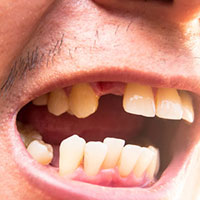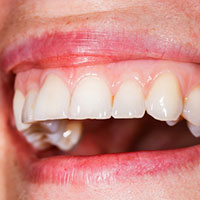When Do Children Lose Their Teeth?
March 1st, 2018
 Think back to when you lost your first tooth as a child. If you were like most kids, you were super excited that the Tooth Fairy would leave you a few dollars under your pillow. The years flew by and now you find yourself asking the same questions that your parents probably did.
Think back to when you lost your first tooth as a child. If you were like most kids, you were super excited that the Tooth Fairy would leave you a few dollars under your pillow. The years flew by and now you find yourself asking the same questions that your parents probably did.
When will my child’s first tooth fall out?
Is there a predictable order in which they fall out?
Being the good parent that you are, it’s natural to be concerned about such a pivotal time in the life of your child. After all, teeth are one of the most important body parts and they play a key role in eating, speech, and even self-confidence.
We have compiled this guide to help answer the various questions you might have regarding the adult teeth of your child coming in.
Why Does Your Child Have Baby Teeth?
On the surface, it seems rather pointless for children to have a baby set of teeth come in, only to wind up losing them a few years later. Baby teeth play a vital role in the development of the mouth and jaw. The muscles and jaw bone require baby teeth for proper spacing.
Baby teeth also act as a guide for permanent teeth. The permanent teeth grow up through the roots of the baby teeth. They also help with speech development and assist a child when its learning to chew.
When Will Your Child Lose Their First Tooth?
Most children will lose their first baby tooth anywhere from four to seven years of age. If their teeth start to become wiggly prior to four years of age, that is slightly earlier than the norm. Check to see if there has been some trauma such as a fall or other object that could have made the tooth wiggly. As long as there is no sign of tooth decay, then there really isn’t a reason for concern.
Girls tend to get and lose their teeth earlier than boys do. Doctors aren’t quite sure why this happens, but it’s thought that it’s due to girls developing faster than boys. If your child has Down syndrome, then you can expect them to lose their baby teeth a little later in life than other children.
In What Order Are Baby Teeth Lost?
A little-known fact about baby teeth is that they’re usually lost in the same exact order that they originally came in. Generally speaking, the bottom two front teeth are the first to be lost. They’re closely followed by the top two front teeth.
Next up are the bottom two lateral incisors, the teeth on either side of the incisors. Last to go are the top two lateral incisors. These eight teeth are usually lost by age 7. The remainder of the baby teeth don’t fall out until age 10 to 12. At age 12, the 12-year molars start to come in.
An interesting fact about permanent teeth is that they will dissolve and reabsorb the roots of the baby teeth. This is why your child usually feels little to no pain or bleeding when their teeth fall out. It’s important that you don’t try to force your child’s baby teeth to come out. Let it happen naturally.
How Should You Prepare Your Child?
The first thing you should do is let your child know that it is perfectly normal to lose teeth at their age. When their first tooth is ready to fall out, it will become very wiggly. While it is ok if they wiggle the tooth (and it could help loosen it up a bit), they should not attempt to force or pull it out. Oftentimes, baby teeth will fall out when your child is routinely brushing their teeth.
Adult teeth are not as white as baby teeth, so you shouldn’t worry if the new teeth coming in don't appear as bright. Their new adult teeth will also have ridges on the biting edges for a while until they get worn down a bit by normal chewing.
Potential Complications
If your child has a loose tooth that refuses to come out, it may need to be pulled by a dentist. Situations like this are somewhat rare, but are nothing to get worried about. Make an appointment with your dentist and they will help extract the stubborn tooth, oftentimes without any pain or bleeding at all.
In other rare cases, sometimes the new teeth will erupt and come in before the old ones are lost. This is completely normal and often referred to as “shark’s teeth” due to the way a shark will lose and gain new teeth.
Pediatric Dentist in the Miracle Mile
If your child has just started losing their teeth, or you have any questions regarding their new adult teeth, call us at (312) 787-2131 or schedule an appointment online. At Water Tower Dental Care, our gentle and compassionate dentists can help keep your child’s new adult teeth healthy and pearly white!

 There are very few people in life who have absolutely perfect teeth. For the rest of us, we have to suffer through cavities, embarrassing dental checkups, and the occasional root canal. While genetics play an important role in who wins the dental lottery, regular maintenance such as brushing and flossing play an even bigger role in preventing tooth decay, cavities, and extractions.
There are very few people in life who have absolutely perfect teeth. For the rest of us, we have to suffer through cavities, embarrassing dental checkups, and the occasional root canal. While genetics play an important role in who wins the dental lottery, regular maintenance such as brushing and flossing play an even bigger role in preventing tooth decay, cavities, and extractions. A “gummy smile” is when a person’s upper gums are very prominently shown when they smile. It is usually characterized by the upper teeth appearing too short, or the upper gums appearing to be too long. This harmless condition is highly subjective – and entirely dependent upon what the person feels is aesthetically pleasing.
A “gummy smile” is when a person’s upper gums are very prominently shown when they smile. It is usually characterized by the upper teeth appearing too short, or the upper gums appearing to be too long. This harmless condition is highly subjective – and entirely dependent upon what the person feels is aesthetically pleasing.
 Cracked or chipped teeth often happen when you least expect it. Whether it’s due to falling, being hit in the face, or biting down on something hard, some people tend to worry that a chipped tooth can’t be fixed. Thankfully, modern dentistry has come a long way over the years and there are several ways a dentist can repair a chipped or broken tooth.
Cracked or chipped teeth often happen when you least expect it. Whether it’s due to falling, being hit in the face, or biting down on something hard, some people tend to worry that a chipped tooth can’t be fixed. Thankfully, modern dentistry has come a long way over the years and there are several ways a dentist can repair a chipped or broken tooth.




 Website Powered by Sesame 24-7™
Website Powered by Sesame 24-7™